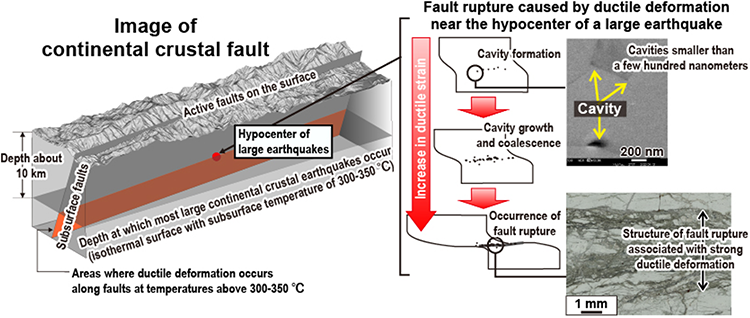Researchers) SHIGEMATSU Norio, Senior Researcher, YEO Thomas, Research Assistant (at the time of the research), Research Institute of Earthquake and Volcano Geology, KOBAYASHI Keita, Senior Researcher, Research Institute for Material and Chemical Measurement
- Geological study of faults exposed on the Earth’s surface near the hypocenter of past large continental crustal earthquakes
- Formation and growth of microcavities in rock caused by ductile deformation, evolving into subsurface fault rupture
- This findings may lead to new earthquake prediction methods.

(Left) Image of a continental crustal fault. Analysis of rocks near the hypocenter of past large earthquakes. (Right) Conceptual diagram of the process of fault rupture caused by ductile deformation. The smallest cavity size is less than a few hundred nanometers.
*Figure modified from Yeo et al.(2025)
Large continental crustal earthquakes caused by active faults have repeatedly occurred in various places in Japan, resulting in significant damage. Evaluation of large earthquakes is one of the most important social issues, and long-term evaluation and evaluation of strong motions on active faults are being conducted to mitigate the potential damages caused by earthquakes. On the other hand, if we can detect the behavior of fault at the hypocenters of large continental crustal earthquakes, which is considered as beginning of fault ruptures, it can improve the current evaluations of active faults.
Most of the hypocenters of large continental crustal earthquakes along active faults are located at depths of around 10 km. At such depths, temperatures reach as high as 300-350 ºC, and rocks are ductilely deformed when force is applied. When a metal receives strong ductile deformation, the formation of microcavities, and the growth and coalescence of these cavities lead to a reduction in strength and eventually cause failure. In this respect, if the development of microcavities can be detected, fracture can be predicted. If the same is true for subsurface rocks, in principle fractures developed near the hypocenter of large continental crustal earthquakes by this mechanism can be predicted.
Researchers at AIST, in collaboration with the University of Tokyo and University of Tsukuba, have identified a case in which strong ductile deformation near the hypocenters of large continental crustal earthquakes led to the rupture of subsurface faults.
Most of the hypocenters of large continental crustal earthquakes along active faults are located at depths of around 10 km. At these depths, the high temperatures cause the rocks to deform ductilely when forces are applied. In Mie Prefecture, the Median Tectonic Line, the largest onshore fault in Japan, contains fault structures near the hypocenter of large earthquakes in the past are exposed on the ground surface. The area fraction of microcavities and the amount of strain due to ductile deformation were determined for rocks collected there. The results show that the area fraction of microcavities increases with the strength of ductile deformation and that rupture along the subsurface fault occurs when the area fraction exceeds 7.5%.
The results of the present study reveal a case in which the development of microcavities due to ductile deformation along faults led to failure phenomena at locations where most large continental crustal earthquakes occur. Similarly, in metals where the development of microcavities due to ductile deformation leads to failure, failure can be predicted if the development of microcavities can be detected. Therefore, the findings obtained in this study would promote the development of short-term prediction technology.
Journal: Journal of Geophysical Research: Solid Earth
Title of paper: Evolution of Nanocavities to Ductile Fractures in Crustal-Scale Faults at the Base of the Seismogenic Zone
Authors: Thomas Yeo, Norio Shigematsu, Simon R. Wallis, Keita Kobayashi, Chunjie Zhang, and Kohtaro Ujiie DOI: 10.1029/2024JB029868